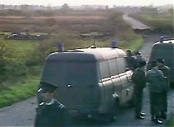
The North’s most senior coroner John Leckey has revealed that new evidence had been uncovered in top secret Crown force files regarding an IRA attack in 1982.
Three members of the RUC were killed when their armoured vehicle was destroyed by a 1,000lb IRA landmine near Lurgan.
It later emerged that the explosives used in the bomb had been hidden in a hayshed that had been under surveillance of the force’s own Special Branch intelligence unit.
Mystery still surrounds the October 1982 bombing, and there have been allegations that a high-level informer was somehow involved.
Within weeks, five republicans and a Catholic teenager were killed in the area in a series of planned Crown force killings, known as ‘shoot-to-kill’ attacks.
On November 11 1982, an undercover RUC unit shot dead IRA men Gervaise McKerr, Eugene Toman and John Burns near Lurgan.
Toman and Burns had been linked to the bomb which had killed the three policemen.
Two weeks later Catholic teenager Michael Tighe was shot dead in a hayshed near Craigavon where the explosives used in the bomb had been under police surveillance.
On December 12 INLA men Seamus Grew and Roddy Carroll were also shot dead near Armagh city.
Deputy Chief Constable John Stalker of Greater Manchester Police was temporarily brought in to investigate the killings but within months was hastily removed from the inquiry in a cover-up by British military intelligence.
For the past 20 years the families of the six men have been engaged in one of the longest legal battles in northern history to discover the full facts behind the shootings.
However, coroner John Leckey caused surprise yesterday when he unexpectedly announced that he now intended to reopen the inquests into the RUC men’s deaths.
The coroner said that “additional and new evidence” and significant information relating to the case had emerged from Mr Stalker’s secret report, which had not been available when the original inquests were held in 1983.
Mr Leckey would not reveal the nature of the evidence uncovered in the Stalker report but his comments have already led to speculation as to whether the IRA attack could have been prevented.
![[Irish Republican News]](https://republican-news.org/graphics/title_gifs/rn.gif)
![[Irish Republican News]](https://republican-news.org/graphics/title_gifs/harp.gif)

